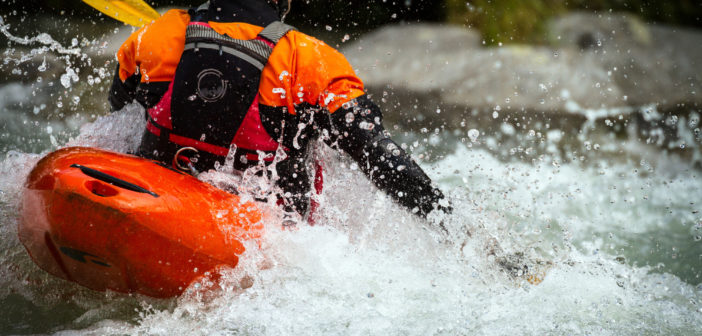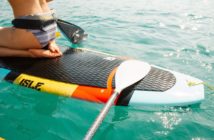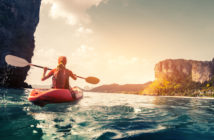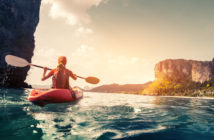Approximately 15.99 million people went kayaking in 2017, a number that has steadily been rising each year since 2006. If you love kayaking, you may be wondering if whitewater kayaking is right for you.
In this post, you’ll learn everything you need to know about this thrilling sport, and whether it may be right for you. Ready? Let’s get started.
Why Try Whitewater Kayaking?
While kayaking is typically about propelling your kayak through relatively still water, whitewater kayaking adds some adrenaline to the experience. That’s because you’re kayaking through a river’s rapids.
If you’re the adventurous type, and you love kayaking, whitewater kayaking may be a natural choice for you.
Kayaking allows you to access places you may otherwise not be able to get to. It also gives you the opportunity to spend time in nature while getting plenty of exercise. But, whitewater kayaking takes this a step further. If you’re someone who suffers from ‘monkey mind‘, you’ll love whitewater kayaking. That’s because you’re 100% focused on getting yourself down the rapid and staying in your kayak.
How to Get Started
If you’d like to try whitewater kayaking, follow the below steps and you’ll be navigating rapids in no time:
Find a Local Club
The Internet is a great way to find like-minded people who also love a slightly more adventurous type of kayaking. Paddling clubs can be a great way to meet new friends and find some people to try whitewater kayaking with for the first time.
Take Lessons
If you’re new to kayaking, you may want to take a few lessons before you introduce fast-moving rapids to your repertoire. Look for a certified instructor for one-on-one lessons if you feel like you’re out of your comfort zone. Alternatively, choose group lessons but make sure they have a student/teacher ratio of no more than 5 to 1.
Choose Your First River Trip
Once you feel comfortable in the water, and you’re ready to hit the river, find a group of paddlers who are planning a trip. Be sure to take plenty of warm clothes and extra gear (in dry bags) as you’ll inevitably spend some time swimming.
It’s normal to feel slightly overwhelmed if you’re used to kayaking on still water. Stay calm, and reach out to more experienced people in your group if you’re feeling nervous. Be sure to take the time to appreciate the beauty around you while you’re navigating the river.
Get the Right Gear
If you’re new to kayaking, you’ll probably prefer to hire the gear you need for your first few trips. Once you’re sure you love whitewater kayaking, it’s time to buy your own gear.
Here are some tips:
Do Your Research
These days, there are so many models and types of whitewater kayaks that choosing between them can be incredibly confusing. Your best bet is to take your time, consult more experienced whitewater kayakers, and do plenty of research.
As a basic guideline, you’ll need to choose between a displacement hull and a planing hull. A planing hull has a flat surface, which can be advantageous in whitewater since they’re easier to turn. They also turn more quickly and with less effort since they sit more on top of the water.
A displacement hull is likely to be faster, which isn’t something you need to worry too much about if you’re navigating rapids. They dip farther below the waterline, meaning it can take a little more effort to turn them.
Consider Speed vs Turning
You’ll also need to consider the type of chines you’d prefer. These are the edges of the kayak’s hull, and they sit below the waterline. The harder the chine, the more performance-orientated they tend to be. Hard chines can be easier to turn quickly, but they also mean you need to be more conscious of your hip angle in the water.
Soft chines tend to excel in rivers (particularly rocky ones), and simply need to be pointed in the right direction.
In general, a narrow kayak will go faster than a wide one. And a longer kayak will go faster than a shorter one (but it will be more difficult to turn). The type of kayak you choose will likely depend on your skill level more than anything else
Get Enough Dry Gear
There are few things more miserable than experiencing the shivering, teeth-chattering feeling of being freezing after an exhilarating river run.
Do yourself a favor and stock up on plenty of dry gear. If you’re doing a straight run down the river, be sure to leave plenty at the other end so you can immediately get changed when you’re finished.
Get to know the Rivers
It’s a good idea to get a guidebook or do some online research about the rivers in your area. Each part of the river will be rated based on the International Scale of River Difficulty.
If you’re new to kayaking, you’ll be able to do the Class I and Class II sections. As you become more experienced, you can move up to more difficult river sections where the whitewater will have higher classes.
Check Flow Updates
Always find the phone numbers and websites that will give you flow updates for the rivers in your area. These can vary greatly based on dam releases and the weather.
You’ll be able to find the minimum flows needed online and in guidebooks. Higher flows will impact the difficulty of the whitewater, so make sure you’re prepared.
Wrapping up
Whether you’re an experienced kayaker looking for something new and exciting, or you’ve been whitewater rafting before and would like to try it in a kayak, this is a great choice. Whitewater kayaking is challenging, fun, and exhilarating. It’s also an excellent way to meet people with similar interests.
By keeping the above tips in mind, you’ll be able to get the most from your experience, stay safe, and potentially find a sport for life.
Looking for a new kayak? Check out our complete guide to help you make your choice.




